How rife is Covid in YOUR area? Interactive map reveals up to one in 14 people were infected
>
The number of people infected with Covid has fallen by a tenth in England, surveillance data suggests.
Around 2.2million people, or one in 25 people, were infected with the virus in the week to January 3, according to figures from the Office for National Statistics (ONS).
The figure is down by 11 per cent in a week, despite health chiefs warning that a mutant Covid strain, dubbed the ‘Kraken’, is set to take-off.
However, as many as one in 14 people were infected in the worst-affected part of the UK. The ONS has released an interactive map that allows you to look up how prevalent the virus was in your local area during the most recent week.
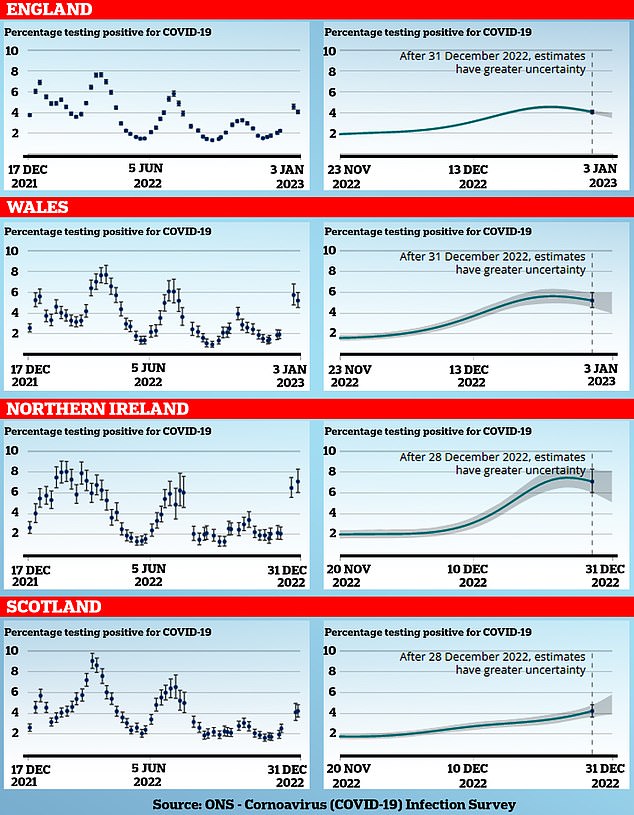
The latest ONS Covid infection survey shows that 4 per cent of England’s population was infected on any given day last week — a drop from 4.5 per cent last week. In Scotland, levels increased by 3 per cent in Scotland to 219,600, meaning one in 25 people (4.1 per cent of the population) were infected in the week to December 31. Around 157,000 people in Wales (one in 18, 5.7 per cent) were thought to be carrying the virus in the seven days to January 3, down 9.4 per cent in a week. In Northern Ireland, 129,100 people were infected (one in 14, 7 per cent) — an increase of 9.3 per cent. However, the ONS said the weekly trend is uncertain
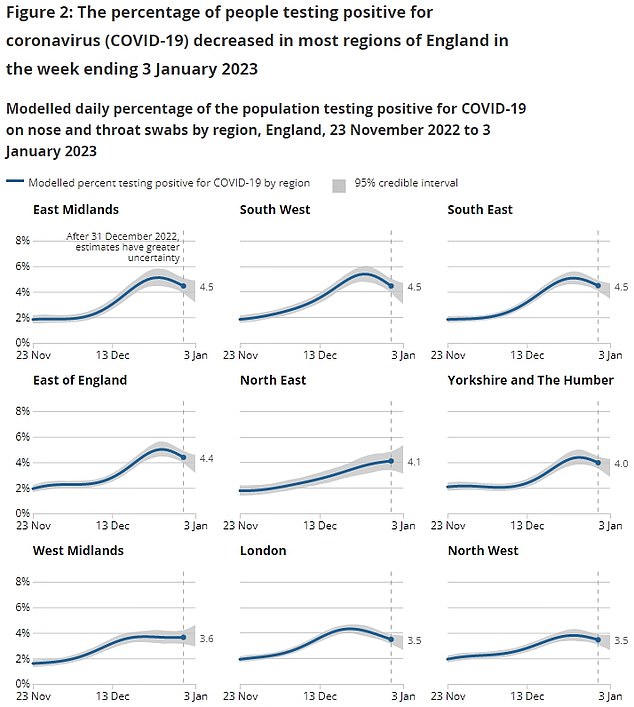

In England, cases fell in all regions apart from the North East, where 4.1 per cent of people were infected — up from 3.8 per cent one week earlier. Infections were highest in the East Midlands, South West and South East, where 4.5 per cent were thought to be carrying the virus. Cases were lowest in London and the North West, where 3.5 per cent are infected, according to ONS estimates
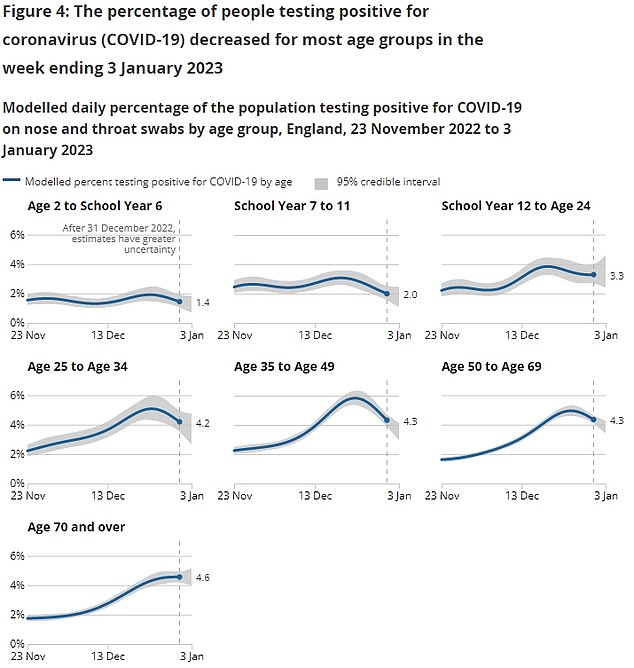

In England, the over-70s were most likely to be carrying the virus (4.6 per cent), followed by 50 to 69-year-olds and 35 to 49-year-olds (4.3 per cent). Rates were lowest in the two to 10-year-old cohort (1.4 per cent), followed by 11 to 16-year-olds (2 per cent)
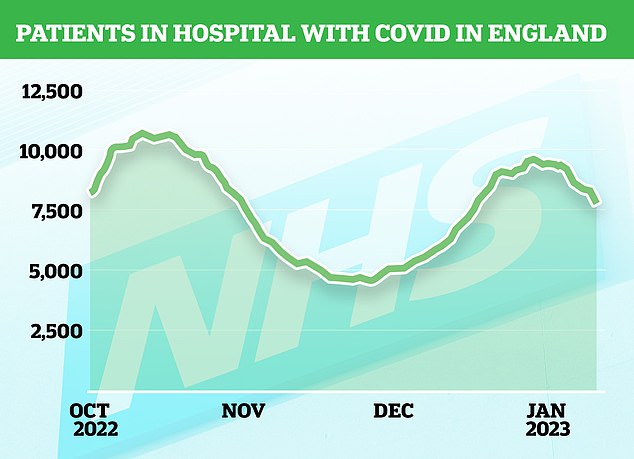

COVID: The number of people infected with Covid taking up hospital beds in England fell 11 per cent from 9,414 in the week to January 4 to 8,404 in the seven days to January 11. NHS data shows the figure peaked at 9,533 on December 29 and has since fallen 19 per cent to 7,743
The latest ONS Covid infection survey shows that 4 per cent of England’s population was infected on any given day last week — a drop from 4.5 per cent one week earlier.
In Scotland, levels increased by 3 per cent to 219,600, meaning one in 25 people (4.1 per cent of the population) were infected in the week to December 31.
Around 157,000 people in Wales (one in 18, 5.7 per cent) were thought to be carrying the virus in the seven days to January 3, down 9.4 per cent in a week.
In Northern Ireland, 129,100 people were infected (one in 14, 7 per cent) — an increase of 9.3 per cent. However, the ONS said the weekly trend is uncertain.
The ONS, which swabs thousands of people across the UK to estimate how prevalent the virus is nation-wide, noted that these estimates are based on a lower than usual number of swabs due to the festive period so have more uncertainty.
In England, cases fell in all regions apart from the North East, where 4.1 per cent of people were infected — up from 3.8 per cent one week earlier.
Infections were highest in the East Midlands, South West and South East, where 4.5 per cent were thought to be carrying the virus.
Cases were lowest in London and the North West, where 3.5 per cent are infected, according to ONS estimates.
Across the whole of the UK, cases appeared to be highest in Belfast, where one in 14 people (7.4 per cent) were infected. At the other end of the scale, just one in 31 people (3.2 per cent) were infected in Bromley.
In England, the over-70s were most likely to be carrying the virus (4.6 per cent), followed by 50 to 69-year-olds and 35 to 49-year-olds (4.3 per cent).
Rates were lowest in the two to 10-year-old cohort (1.4 per cent), followed by 11 to 16-year-olds (2 per cent).
Michelle Bowen, head of health surveillance dissemination and strategy, said: ‘Although infections have decreased in England and Wales, rates remain high in both nations.
‘Scotland has seen another week of increases, whilst the trend in Northern Ireland is uncertain.
‘Cases have decreased across most English regions and age groups; however, infections continue to rise in the over 70s.
‘We will continue to monitor the data closely.’
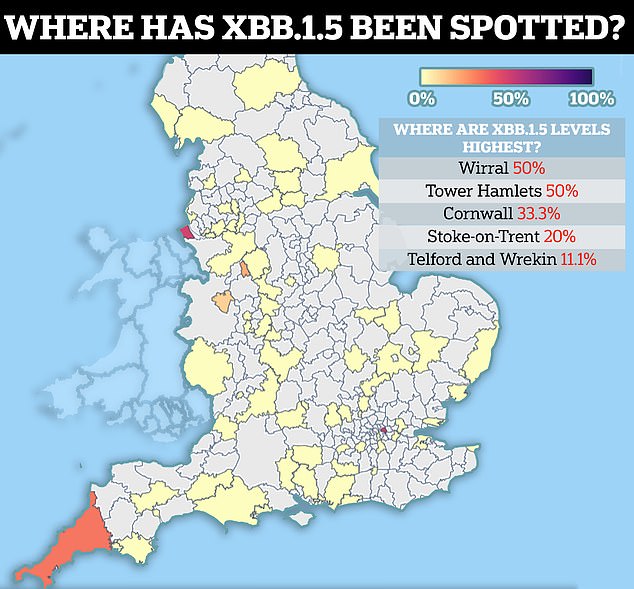

Covid cases are estimated to have doubled during December, just as the XBB.1.5 ‘Kraken’ variant began to sweep Britain. Analysts say almost three million people had the virus in the festive week
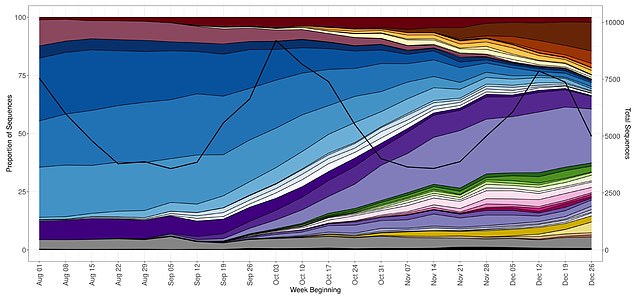



In the week to Boxing Day, 227 sequenced Covid samples (4.5 per cent) were XBB.1.5 (light yellow), while 617 (12.4 per cent) were CH.1.1 (dark red), according to UKHSA data
The ONS noted that since the end of June, Omicron variant BA.5 or its sub-lineages have been behind the majority of infections.
Its analysis suggests that two other Omicron spin-offs, XBB.1.5 and, nicknamed ‘Kraken’ and ‘Orthrus’, were behind 7.1 per cent and 19.1 per cent of cases, respectively, in the week to Christmas.
While CH.1.1 is behind more infections, XBB.1.5 appears to be growing faster and is thought to be more transmissible and immune evasive than other strains in circulation, experts say.
Scientists at the UK Health Security Agency expect that one of the strains will become dominant in the coming weeks.
This is because XBB.1.5 has a 39 per cent growth rate advantage over the dominant variant, while CH.1.1 is spreading 22 per cent faster.
Writing in a technical briefing on Wednesday, they said the two strains are ‘currently the variants most likely to predominate in the UK’ unless a more transmissible variant is arises.
The UKHSA said: ‘It is plausible that XBB.1.5 will cause an increase in incidence after the current wave, however it is currently too early to confirm this trajectory.’
The ‘Orthrus’ strain was deemed an official variant by the UKHSA in December, while ‘Kraken’ has been tracked more carefully since Monday.
CH.1.1 has mutations including P681R — which was also on the Delta variant — and is thought to make it better attack cells and cause more severe illness.
Scientists have also spotted R346T, which is thought to help the strain fight-off antibodies that were generated in response to vaccination or previous infection.
Amid warnings of the upcoming wave, the number of people infected with Covid taking up hospital beds is falling.
The figure dropped 11 per cent from 9,414 in the week to January 4 to 8,404 in the seven days to January 11.
NHS data shows Covid patients peaked at 9,533 on December 29 and has since fallen 19 per cent to 7,743.
Just one in three so-called Covid patients are primarily admitted to hospital because of the virus. The remaining two-thirds were taken into NHS care for another ailment, such as a broken leg, but happened to test positive.
If the downwards trend continues, it means hospitalisations will have peaked below 10,000, which is well below the figures seen in previous waves.
The number topped 14,000 during summer 2022 and reached 17,000 last winter.
In other health news…
UK suffers worst year for scarlet fever since the 1950s… so was YOUR area a hotspot?
Think twice before having a fertility MOT! Experts fear tests sold on High Street can open ‘Pandora’s box’ and convince couples to unnecessarily fork out thousands to freeze their eggs
Are striking NHS staff on brink of new £3bn pay deal? Steve Barclay ‘admits 1million medics deserve one-off cash boost… but Treasury says he’ll have to raid his OWN budget’
